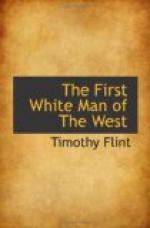The whole party crossed the river, keeping straight forward in the beaten buffalo road. Advanced a little, parties flanked out from the main body, as the irregularity and unevenness of the ground would allow. The whole body moved on in reckless precipitation and disorder, over a surface covered with rocks, laid bare by the trampling of buffaloes, and the washing of the rain of ages. Their course led them in front of the high ridge which extends for some distance to the left of the road. They were decoyed on in the direction of one of the ravines of which we have spoken, by the reappearance of the party of Indians they had first seen.
The termination of this ridge sloped off in a declivity covered with a thick forest of oaks. The ravines were thick set on their banks with small timber, or encumbered with burnt wood, and the whole area before them had been stripped bare of all herbage by the buffaloes that had resorted to the Licks. Clumps of soil here and there on the bare rock supported a few trees, which gave the whole of this spot of evil omen a most singular appearance. The advance of the party was headed by McGary, Harland, and McBride. A party of Indians, as Boone had predicted, that had been ambushed in the woods here met them. A warm and bloody action immediately commenced, and the rifles on either side did fatal execution. It was discovered in a moment that the whole line of the ravine concealed Indians, who, to the number of thrice that of their foes, rushed upon them. Colonels Todd and Trigg, whose position had been on the right, by the movement in crossing, were thrown in the rear. They fell in their places, and the rear was turned. Between twenty and thirty of these brave men had already paid the forfeit of their rashness, when a retreat commenced under the edge of the tomahawk, and the whizzing of Indian bullets. When the party first crossed the river all were mounted. Many had dismounted at the commencement of the action. Others engaged on horseback. On the retreat, some were fortunate enough to recover their horses, and fled on horseback. Others retreated on foot. From the point where the engagement commenced to the Licking river was about a mile’s distance. A high and rugged cliff environed either shore of the river, which sloped off to a plain near the Licks. The ford was narrow, and the water above and below it deep. Some were overtaken on the way, and fell under the tomahawk. But the greatest slaughter was at the river. Some were slain in crossing, and some on either shore.
A singular spectacle was here presented in the case of a man by the name of Netherland, who had been derided for his timidity. He was mounted on a fleet and powerful horse, the back of which he had never left for a moment. He was one of the first to recross the Licking. Finding himself safe upon the opposite shore, a sentiment of sympathy came upon him as he looked back and took a survey of the scene of murder




